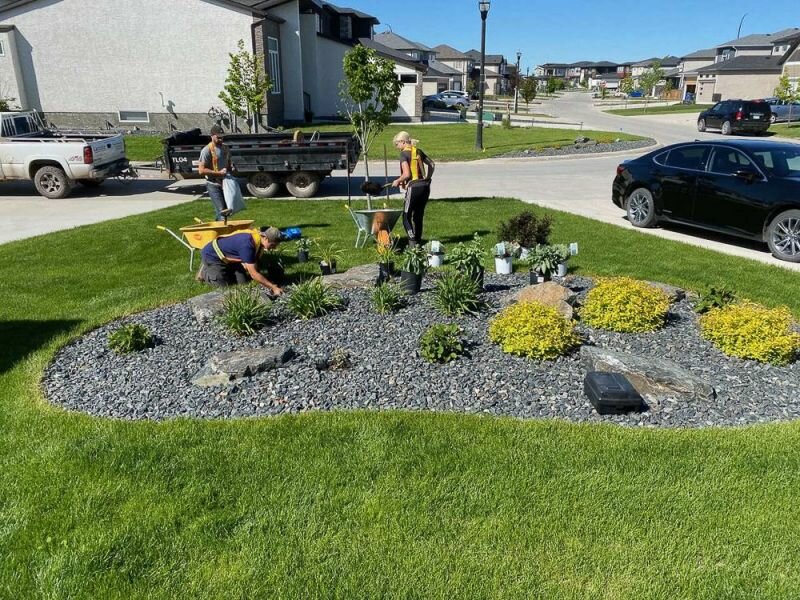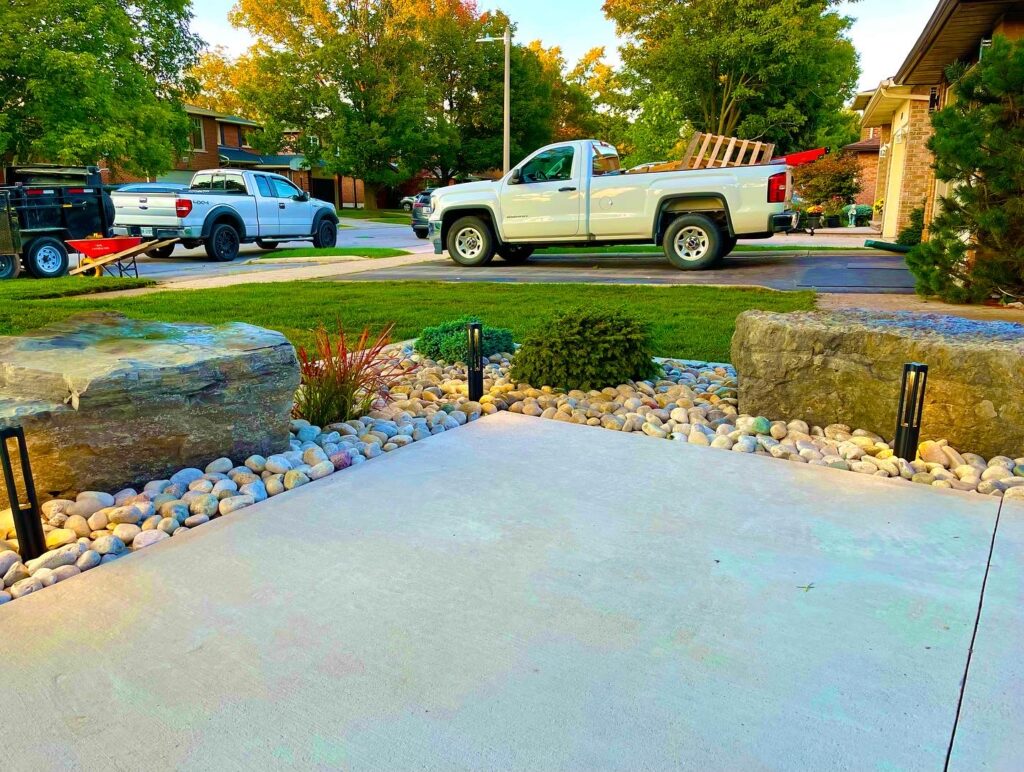Top components behind effective landscaping services
Understanding the Comprehensive Extent of Works in Specialist Landscaping Services
The comprehensive scope of professional landscaping services incorporates a selection of basic components. It consists of landscape layout principles, plant choice, and hardscaping functions. Furthermore, it addresses irrigation systems and maintenance methods. Each aspect plays a crucial role in developing useful and visually pleasing exterior rooms. Understanding how these elements work together can expose much regarding the art and science of landscaping. Nevertheless, the trip into this elaborate area is just beginning.

Landscape Layout Concepts
Efficient landscape style principles are vital for creating unified outside areas that improve both visual appeal and performance. These principles assist the setup of components within the landscape, making certain a natural aesthetic experience. Key components consist of balance, which distributes visual weight evenly; percentage, which associates the size of different aspects per various other and the space; and unity, which creates a sense of wholeness through regular motifs and materials.
Emphasis directs interest to focal points, while rhythm establishes motion via rep of design functions. The efficient use line can create pathways and guide the eye via the landscape. On top of that, comprehending the site's topography, climate, and existing functions is essential for integration with the surrounding environment. By adhering to these foundational principles, landscape designers can craft spaces that not only look appealing however likewise offer their desired function, boosting the general experience for customers.
Plant Option and Setup
In the domain name of professional landscaping, plant option and installment play a vital role in achieving a flourishing yard - landscaping services. Emphasizing indigenous plant benefits, seasonal considerations, and the certain dirt and sunlight needs of each varieties ensures a sustainable and visually pleasing landscape. Cautious planning in these locations not only boosts biodiversity yet also advertises long-lasting environmental wellness
Native Plant Benefits
Why should home owners consider native plants for their landscaping jobs? Indigenous plants provide numerous advantages that enhance both appearances and environmental sustainability. They are well-adapted to regional environments, calling for much less water and upkeep contrasted to non-native types. This durability reduces the need for chemical fertilizers and chemicals, promoting a much healthier ecosystem. Furthermore, native plants supply habitat and food for neighborhood wildlife, consisting of pollinators, which can increase biodiversity in household areas. Their knowledge with regional soil and climate condition likewise leads to much better growth prices and longevity. By picking native plants, home owners not just create aesthetically attractive landscapes but additionally add to ecological preservation, making a favorable effect on their local setting. Indigenous plants represent a smart choice for landscaping projects.
Seasonal Plant Considerations
Property owners that have actually welcomed indigenous plants in their landscaping can further boost their exterior areas by taking into consideration seasonal plant choices. By incorporating plants that prosper in particular seasons, they can create visually appealing and dynamic landscapes throughout the year. Spring may introduce vivid blossoms like daffodils and tulips, while summer season can display lavish vegetation and colorful perennials. Autumn introduces a palette of warm tones with asters and goldenrods, while wintertime can be emphasized with evergreens and decorative turfs for structure. Specialist landscapers often suggest choosing plants that not only enhance existing native varieties but additionally provide year-round rate of interest and support neighborhood wildlife. This thoughtful method to seasonal plant selection ensures a continuously progressing and sustainable garden environment.
Soil and Sunshine Needs
Effective landscape design depends upon understanding the specific dirt and sunshine requirements of plants. Different species flourish under varying conditions, requiring a cautious evaluation of both elements during the selection process (landscaping services). Dirt kinds, such as sandy, clay, or loamy, influence drainage, nutrition availability, and root growth. In addition, pH levels can affect plant wellness, demanding dirt testing to determine suitability. Sunlight needs differ significantly; some plants thrive in complete sun, while others choose full or partial shade. An expert landscaping company takes into consideration these components to assure peak growth and visual charm. By aligning plant options with the environment's certain qualities, landscapes can attain sustainability, durability, and aesthetic harmony, eventually leading to effective plant facility and lasting maintenance
Hardscaping Features and Construction
While landscape design typically evokes pictures of lush plant and dynamic flowers, hardscaping attributes play an important duty in specifying outside spaces. These aspects, that include patios, pathways, preserving wall surfaces, and decorative stonework, give structure and capability to yards and gardens. Hardscaping makes use of materials such as concrete, block, rock, and wood, enabling diverse styles that match the all-natural landscape.
The construction of hardscaping functions needs mindful preparation and execution to guarantee durability and aesthetic charm. Specialists analyze site conditions, water drainage, and spatial relationships to create cohesive exterior environments. Appropriate installation techniques are crucial, as they protect against issues like disintegration and shifting with time.
Integrating hardscaping not only improves the visual interest of a home but also facilitates outdoor tasks, making it a basic facet of detailed landscape design services. Eventually, thoughtful hardscaping adds to both the performance and beauty of outdoor spaces.
Watering Equipments and Water Administration
Efficient irrigation systems and water administration are crucial parts of professional landscape design, as they assure that plants receive the required hydration for excellent growth. These systems can vary from straightforward drip irrigation arrangements to innovative automatic lawn sprinkler, developed to fulfill the details requirements of diverse landscapes. Appropriate water administration not just maximizes water use, decreasing waste, however likewise improves plant health and wellness and decreases condition threats.
Landscape design specialists analyze numerous factors, including soil type, plant types, and neighborhood climate, to create tailored watering remedies. In addition, integrating rain harvesting methods can further boost sustainability and efficiency (Read More). Normal upkeep of irrigation systems is vital to keep functionality and protect against leaks, which can cause water loss and enhanced prices. Ultimately, a properly designed irrigation system plays a critical function in protecting the aesthetic appeal of exterior rooms while advertising environmental stewardship within expert landscaping methods
Yard Care and Maintenance Techniques
Yard treatment and maintenance methods are fundamental for attaining a lush, healthy backyard that improves the overall landscape. These methods include various techniques intended at advertising perfect growth and visual appeal. Routine mowing is crucial, as it encourages thick, also growth while preventing weeds from establishing. Furthermore, proper fertilization gives essential nutrients, with applications tailored to the details lawn kind and dirt conditions.
Watering methods ought to focus on deep, irregular irrigation to urge root growth, while oygenation enhances dirt structure and promotes nutrition absorption. Insect and illness administration is additionally essential; identifying problems early enables effective therapies that lessen damage.
Ultimately, overseeding can revitalize slim or broken yards, enhancing thickness and color (landscaping services). By implementing these targeted lawn treatment strategies, landscape design specialists can assure that lawns stay vivid and healthy and balanced throughout the seasons, considerably contributing to the overall elegance of the property
Seasonal Landscape Treatment and Upkeep
As the seasons modification, appropriate landscape treatment comes to be important for preserving the health and appeal of exterior spaces. Each period presents special obstacles and requirements. In springtime, landscape professionals concentrate on trimming, growing, and fertilizing to urge growth. Summer season needs routine watering, weed control, and pest administration to protect recently established plants.
Autumn calls for the prep work of gardens for winter months, consisting of mulching, fallen leave elimination, and the growing of bulbs for the following springtime. In addition, winter care includes safeguarding prone plants from frost and guaranteeing that hardscapes are secure and useful.
Throughout the year, seasonal landscape maintenance assurances that exterior locations remain healthy and visually appealing. Professional services can supply tailored maintenance strategies that adjust to the details requirements of each period, enabling homeowner to take pleasure in vivid landscapes year-round. Generally, seasonal treatment is a vital element of specialist landscaping that advertises longevity and aesthetic value.
Sustainable Landscaping Practices
A growing number of residential property owners are embracing sustainable landscaping techniques to create eco friendly outdoor rooms. These methods concentrate on saving sources, enhancing biodiversity, and lessening environmental effect. Indigenous plants are usually selected for their low tide requirements and compatibility with neighborhood ecosystems, decreasing the demand for chemical plant foods and chemicals. Rain yards and absorptive paving are utilized to manage stormwater runoff, advertising groundwater recharge and minimizing disintegration.
In addition, lasting landscape design includes organic gardening methods that prioritize soil health and promote natural bug control. Reliable irrigation systems, such as drip basics watering and rainwater harvesting, assistance optimize water usage. Furthermore, landscape designers progressively promote for the usage of recycled products, such as recovered wood and rocks, to minimize waste. By taking on these sustainable practices, homeowner not just add to environmental conservation however additionally produce visually pleasing environments that can love very little maintenance.
Regularly Asked Concerns
For how long Does a Landscape Design Project Typically Take to Full?
Generally, a landscape design job can take anywhere from a few days to a number of weeks to finish, depending upon the task's size, intricacy, and style demands. Read More. Elements such as weather and source accessibility also influence timelines
What Factors Impact the Cost of Landscape Design Services?
Various variables affect landscape design service costs, including job size, design intricacy, material quality, labor costs, geographic area, and seasonal demand. Each aspect contributes uniquely to the general monetary requirements of a landscape design project.
Are Landscaping Solutions Available Year-Round?
Landscape design services are typically readily available year-round, although availability might vary based on region, seasonal climate condition, and particular service offerings. Some services may be limited throughout severe climate or off-peak seasons.
Do Landscape Design Business Deal Warranties on Their Job?

Can I Design My Landscape Without Professional Help?
Yes, people can create their landscapes without specialist aid. However, they may lack knowledge in plant choice, layout, and ecological factors to consider, possibly resulting in less effective styles that could require expensive adjustments later.
